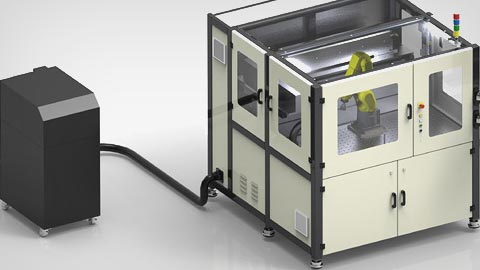Excellent return on CAD investment
Excellent return on CAD investment

Case Study
Engineering laser-based solutions with Solid Edge
Control Micro Systems
Control Micro Systems uses 3D data throughout the product lifecycle
Founded in 1983 as an early innovator in software controls development, Control Micro Systems grew rapidly into being a supplier of complete industrial laser systems. The company built its reputation on providing industry-leading solutions for laser-based applications. This capability includes automated or robotic part handling along with vision and validation. Control Micro Systems has a large global installed base dealing with a wide variety of materials and applications from research and development (R&D) to high-volume manufacturing.
As the industrial applications of laser technology have grown, the company has enjoyed continuous growth and business success, even in challenging economic times.
At its headquarters in Orlando, Florida, the company has mechanical, electrical, and software engineering departments as well as a machine shop. A state-of-the-art applications laboratory staffed by experts in laser, optics and power technologies helps the company research and test laser solutions for drilling, cutting, welding, marking, etching, engraving, ablation, additive manufacturing and annealing processes on a wide range of materials.
Control Micro Systems products have won recognition for design excellence, including a recent award for a printed circuit board (PCB) marking system and another for a laser wire marking machine. The company serves customers throughout the world. “We are one of the few companies that are actually selling million-dollar systems to countries like China and India, instead of the other way around,” says Art Almquist, mechanical engineering manager at Control Micro Systems.
Adopting 3D engineering
Until 2007, Control Micro Systems was performing all of its mechanical engineering work using 2D computer-aided design (CAD). At that time, the company sought to improve its development processes, and looked to 3D CAD to overcome some limitations of 2D-based design. Most importantly, the investment in 3D CAD would enable the company to deliver comprehensive and accurate design information for fabrication in the in-house machine shop.
In addition, 3D models would provide a superior focal point for design reviews, enabling all of the departments and disciplines in the company ‒ electrical engineering, software engineering, manufacturing, project management, sales and field service ‒ to examine the design in detail, identify issues and make suggestions for refinement. Furthermore, prospective customers could better understand proposed projects when presented with 3D models instead of 2D drawings. “We were tired of 2D CAD, and our customers couldn’t understand what they were looking at,” says Almquist.
After formal presentations from CAD vendors, the company evaluated the capabilities of several systems, and chose Solid Edge® software from product lifecycle management (PLM) specialist Siemens Digital Industries Software. Some of the factors in the selection included favorable press and technical reviews of Solid Edge, as well as the fact that Siemens Digital Industries Software also provided the Parasolid® software modeling kernel used in Solid Edge and many competing systems. “Solid Edge had the best interoperability and a rich feature set,” says Almquist. “We feel that it’s a superior tool. Over the years we have hired engineers who were proficient with other systems, and after a few days they have all been happy to be working with Solid Edge.”
